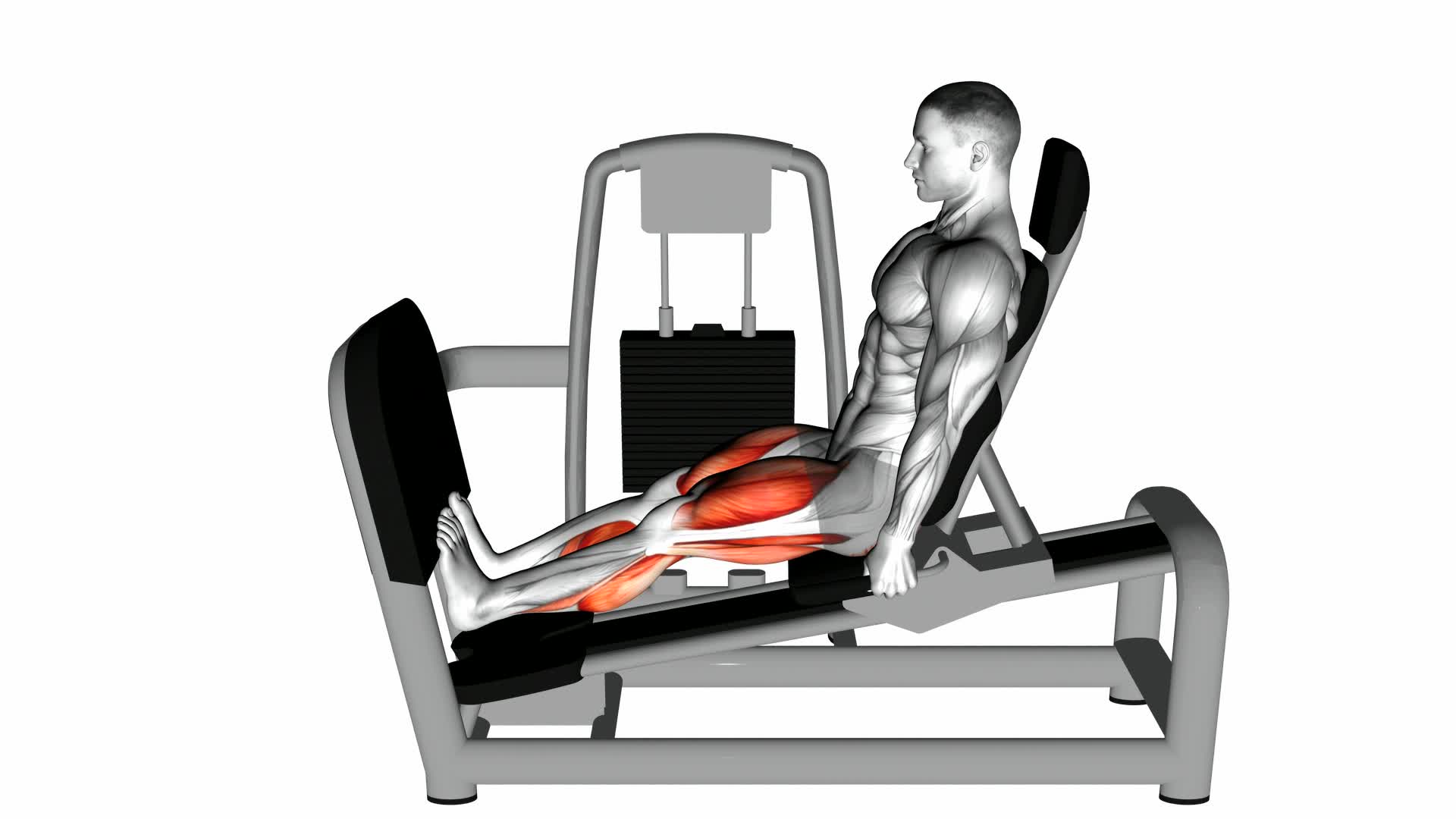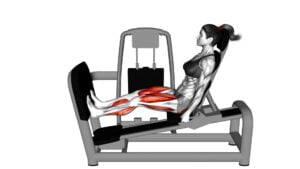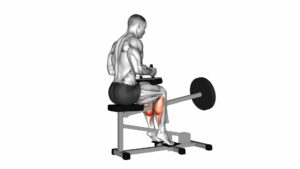Lever Seated Squat Calf Raise on Leg Press Machine – Video Exercise Guide & Tips

In this video exercise guide, you'll learn how to perform the lever seated squat calf raise on the leg press machine. This powerful exercise targets your calf muscles and can be a great addition to your leg workout routine.
Watch This Exercise Video
With proper setup and positioning, along with tips for maximizing calf muscle engagement, you'll be on your way to stronger and more defined calves.
Watch the video and get ready to take your calf training to the next level!
Key Takeaways
- Proper setup and execution of the calf raise movement is important, including maintaining contact with the seat, keeping knees slightly bent, and avoiding locking knees.
- Common mistakes to avoid during the calf raise exercise include using too much weight, not maintaining proper alignment, shortening the range of motion, and rushing through the exercise.
- Variations and modifications of the calf raise exercise include single-leg calf raise, weighted calf raise, heel inward or outward position, and explosive calf raise.
- To maximize calf muscle engagement, it is recommended to keep feet flat on the footplate, push through the balls of the feet, and incorporate other calf strengthening exercises and stretches into the routine.
Proper Setup and Positioning
To properly set up and position yourself for the lever seated squat calf raise on the leg press machine, sit with your back against the seat and your feet placed shoulder-width apart on the footplate. Ensuring proper form is essential for maximizing the benefits of seated squats and preventing injuries.
Firstly, sitting with your back against the seat provides stability and support throughout the exercise. This helps maintain a neutral spine position and prevents unnecessary strain on your lower back. It's crucial to maintain this contact throughout the movement.
Secondly, placing your feet shoulder-width apart on the footplate ensures proper alignment and balance. This stance allows you to engage multiple muscle groups, including your calves, quadriceps, and glutes. It also helps distribute the load evenly across your legs, reducing the risk of muscle imbalances and injuries.
Additionally, keep your knees slightly bent throughout the exercise. This helps maintain tension in your muscles and prevents excessive stress on your joints. It's important to avoid locking your knees, as this can lead to injury.
Executing the Calf Raise Movement
Now, let's focus on how to execute the calf raise movement during the lever seated squat on the leg press machine. Follow these steps to perform the calf raise correctly:
- Begin by sitting on the leg press machine with your feet flat on the calf raise platform, shoulder-width apart.
- Adjust the seat and foot platform so that your knees are slightly bent and your heels are hanging off the edge.
- Slowly raise your heels by extending your ankles, lifting your bodyweight using your calf muscles.
- Pause for a moment at the top of the movement, feeling the contraction in your calves.
- Lower your heels back down to the starting position in a controlled manner.
Executing the calf raise movement during the lever seated squat on the leg press machine provides several benefits, including strengthening and toning the calf muscles. It also improves ankle stability and can enhance overall leg strength.
While the lever seated squat calf raise is an effective exercise, there are alternative calf raise exercises you can incorporate into your routine. These include standing calf raises, seated calf raises, and single-leg calf raises.
Now that you know how to perform the calf raise correctly, let's move on to the next section where we'll discuss common mistakes to avoid during this exercise.
Common Mistakes to Avoid
Avoid these common mistakes when performing the lever seated squat calf raise on the leg press machine. Proper form is crucial for maximizing the effectiveness of this exercise and preventing injury.
One common error is using too much weight. It's important to start with a manageable weight and gradually increase as your strength improves. Using excessive weight can compromise your form and put unnecessary strain on your muscles and joints.
Another common mistake isn't maintaining proper alignment. Make sure your knees are in line with your toes and your feet are hip-width apart. This will ensure that you're targeting your calf muscles effectively. Additionally, avoid rounding your back or leaning too far forward during the movement. Keep your spine neutral and engage your core to maintain stability.
Form corrections are also necessary for the full range of motion. Many people tend to shorten the movement by not fully extending their ankles at the top of the exercise. To correct this, focus on pushing through your toes and fully extending your ankles to engage your calf muscles fully.
Lastly, rushing through the exercise is another mistake to avoid. Slow and controlled movements are essential for targeting the calf muscles effectively. Take your time and focus on the contraction and extension of your calves with each repetition.
Variations and Modifications
To add variety and challenge to your calf workout, try incorporating different variations and modifications of the lever seated squat calf raise on the leg press machine. These variations are designed to target specific calf muscles and cater to different fitness levels. Here are four options to consider:
- Single-leg calf raise: Perform the exercise using only one leg at a time. This variation increases the intensity and stability required, making it more challenging.
- Weighted calf raise: Hold a dumbbell or a weight plate on your thighs while performing the calf raise. This added resistance helps to further strengthen your calf muscles.
- Heel inward or outward position: Adjusting the angle of your feet by turning your heels inward or outward targets different muscles within your calves. Experiment with different foot positions to engage various muscle groups.
- Explosive calf raise: Increase the speed and power of your calf raises by performing them explosively. This variation enhances muscular power and can be especially beneficial for athletes involved in sports that require quick bursts of speed.
Tips for Maximizing Calf Muscle Engagement
Maximize calf muscle engagement by focusing on proper form and technique during the lever seated squat calf raise on the leg press machine. To ensure maximum engagement of your calf muscles, it's important to perform the exercise correctly and incorporate other calf muscle strengthening exercises and calf muscle stretches into your routine.
When performing the lever seated squat calf raise, make sure to keep your feet flat on the footplate and your heels hanging off the edge. This will allow for a full range of motion and better activation of the calf muscles. As you raise the weight, focus on pushing through the balls of your feet and squeezing your calf muscles at the top of the movement.
In addition to the lever seated squat calf raise, there are other exercises that can help strengthen your calf muscles. Standing calf raises, both with bodyweight and added resistance, are a great way to target the calves. Seated calf raises, using a machine or free weights, can also be effective.
To further enhance calf muscle engagement and prevent muscle imbalances, it's important to include calf muscle stretches in your routine. Stretching the calf muscles before and after your workout can help improve flexibility and prevent injuries.
Frequently Asked Questions
How Many Sets and Reps Should I Do for the Lever Seated Squat Calf Raise on the Leg Press Machine?
For the lever seated squat calf raise on the leg press machine, it's important to find the optimal weight and resistance that challenges you but allows for proper form. Start with a weight that you can comfortably lift for 10-12 reps.
Aim for 3-4 sets of this exercise, resting for about 60 seconds between sets.
To make the calf raise more effective, try different variations like single-leg raises or adding pauses at the top of the movement.
Can I Do This Exercise if I Have a Knee Injury?
Yes, you can still do this exercise even if you have a knee injury. However, it's important to consult with a healthcare professional or physical therapist before attempting any exercises.
They can provide alternative exercises for knee injury recovery and guide you on the proper form and modifications for the lever seated squat calf raise with a knee injury.
Remember to prioritize your safety and listen to your body throughout the exercise.
Should I Use Heavy Weights for This Exercise?
When doing the Lever Seated Squat Calf Raise on the Leg Press Machine, it's important to consider weight selection. Using heavy weights can be beneficial for building strength and muscle, but it's crucial to maintain proper form and technique.
Focus on finding a weight that challenges you without compromising your form. Remember to start with lighter weights and gradually increase the load as you progress. This will help you avoid injury and maximize the effectiveness of the exercise.
Can I Do This Exercise Barefoot?
Yes, you can do this exercise barefoot.
Barefoot training has several benefits, such as improved balance, foot strength, and proprioception.
However, if you prefer to wear shoes, you can use alternatives to the lever seated squat calf raise on the leg press machine.
Some options include standing calf raises, seated calf raises with dumbbells, or using a calf raise machine.
Remember to choose a variation that suits your fitness level and goals.
What Is the Ideal Tempo for Performing the Calf Raise Movement on the Leg Press Machine?
The ideal tempo for performing the calf raise movement on the leg press machine is to go slow and controlled. This will help you maximize the benefits of the lever seated squat calf raise exercise.
By going slow, you engage your calf muscles more effectively and build strength and endurance. It also reduces the risk of injury.
Conclusion
To effectively engage your calf muscles, try incorporating the lever seated squat calf raise on the leg press machine into your workout routine.
This exercise helps to target and strengthen the calves while also improving balance and stability.
Be sure to maintain proper setup and positioning, avoid common mistakes, and consider variations and modifications to challenge yourself further.
With these tips, you can maximize your calf muscle engagement and achieve your fitness goals.

Author
Years ago, the spark of my life’s passion ignited in my mind the moment I stepped into the local gym for the first time. The inaugural bead of perspiration, the initial endeavor, the very first surge of endorphins, and a sense of pride that washed over me post-workout marked the beginning of my deep-seated interest in strength sports, fitness, and sports nutrition. This very curiosity blossomed rapidly into a profound fascination, propelling me to earn a Master’s degree in Physical Education from the Academy of Physical Education in Krakow, followed by a Sports Manager diploma from the Jagiellonian University. My journey of growth led me to gain more specialized qualifications, such as being a certified personal trainer with a focus on sports dietetics, a lifeguard, and an instructor for wellness and corrective gymnastics. Theoretical knowledge paired seamlessly with practical experience, reinforcing my belief that the transformation of individuals under my guidance was also a reflection of my personal growth. This belief holds true even today. Each day, I strive to push the boundaries and explore new realms. These realms gently elevate me to greater heights. The unique combination of passion for my field and the continuous quest for growth fuels my drive to break new ground.



